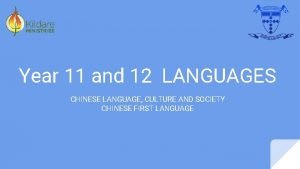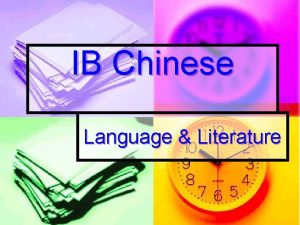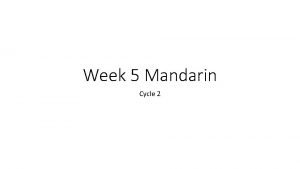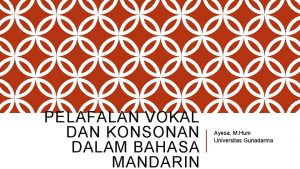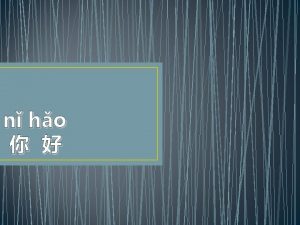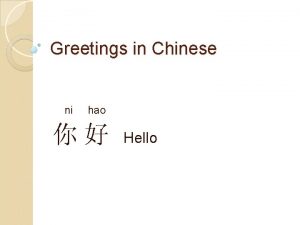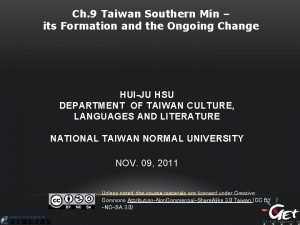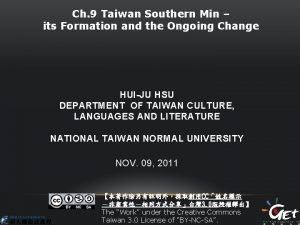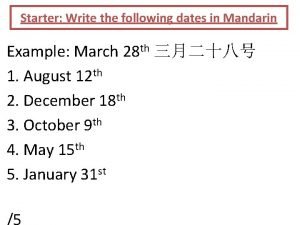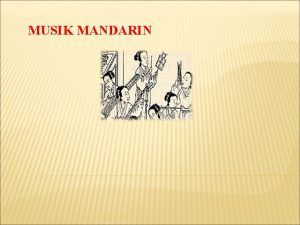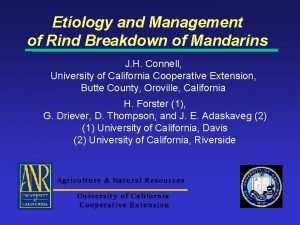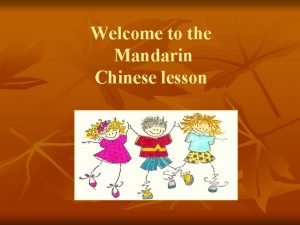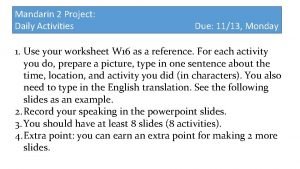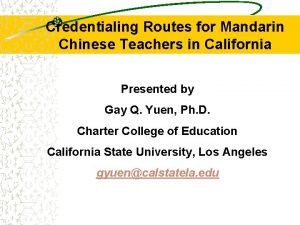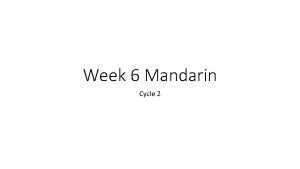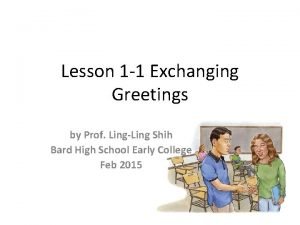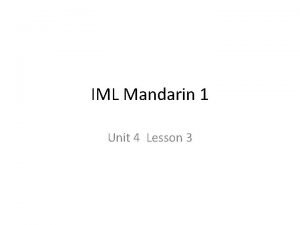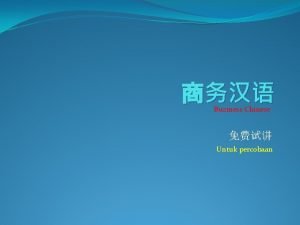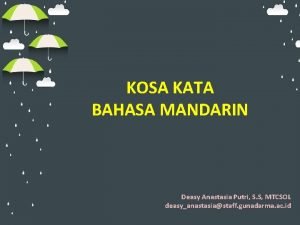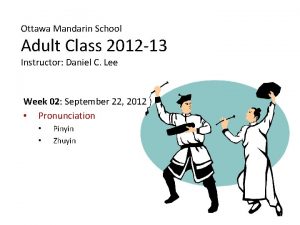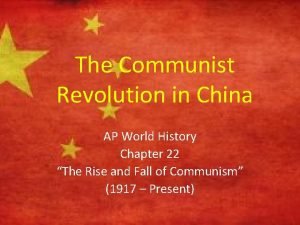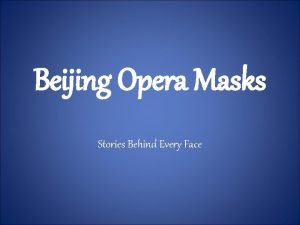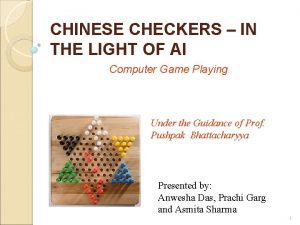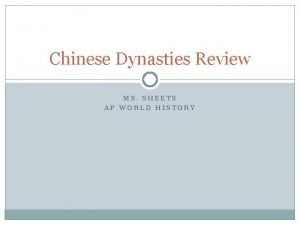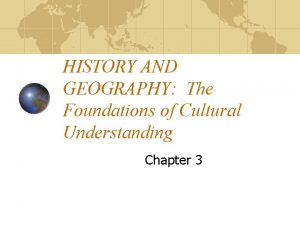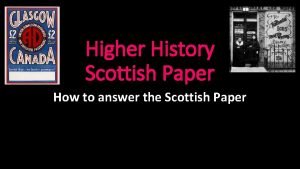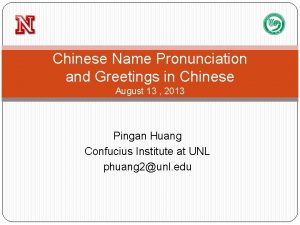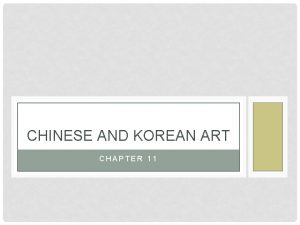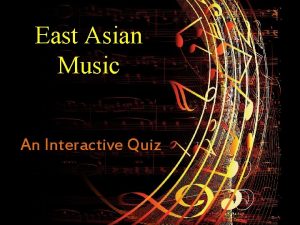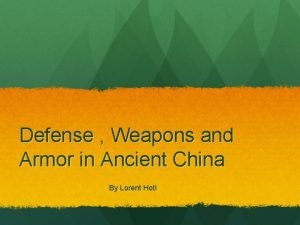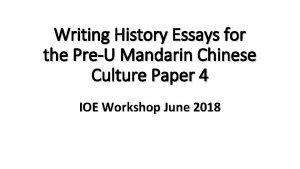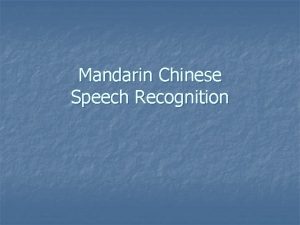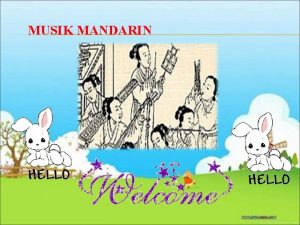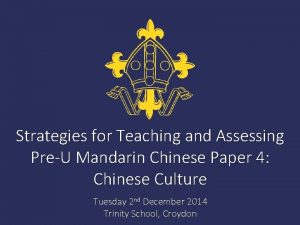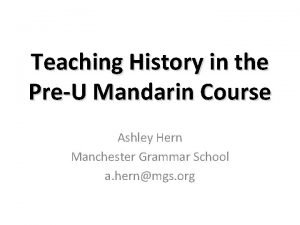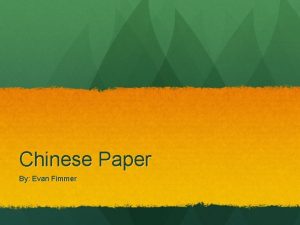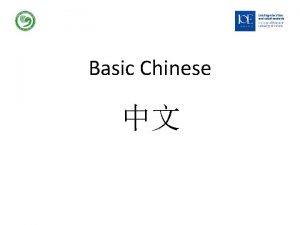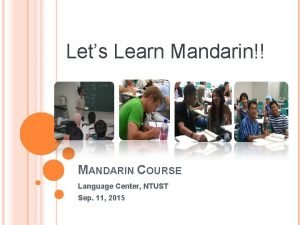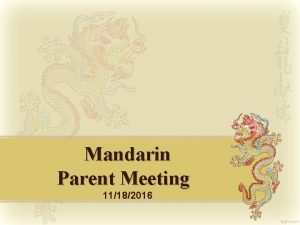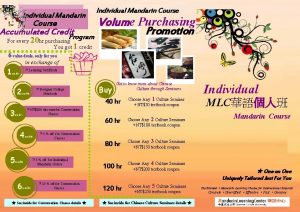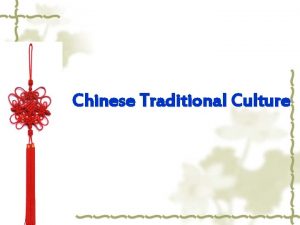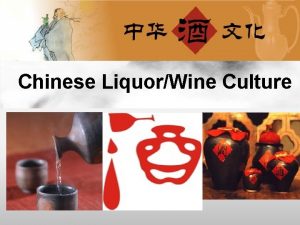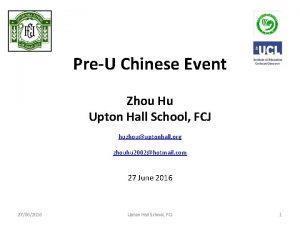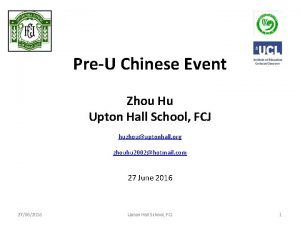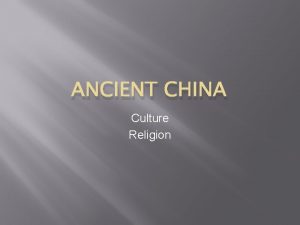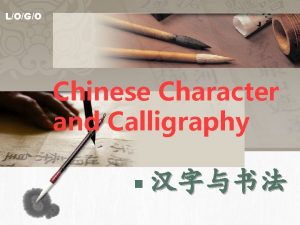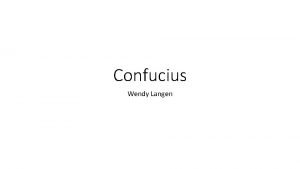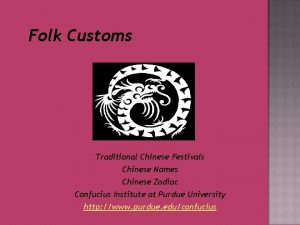PreU Mandarin Paper 4 Chinese History and Culture

![A little bit about me… • Starting learning Chinese at University [Leeds BA Chinese-Portuguese] A little bit about me… • Starting learning Chinese at University [Leeds BA Chinese-Portuguese]](https://slidetodoc.com/presentation_image_h/dc057551088e26a55c0d16bd244847f3/image-2.jpg)



































































- Slides: 69

Pre-U Mandarin Paper 4 Chinese History and Culture Ruairí Garvey – Oundle School
![A little bit about me Starting learning Chinese at University Leeds BA ChinesePortuguese A little bit about me… • Starting learning Chinese at University [Leeds BA Chinese-Portuguese]](https://slidetodoc.com/presentation_image_h/dc057551088e26a55c0d16bd244847f3/image-2.jpg)
A little bit about me… • Starting learning Chinese at University [Leeds BA Chinese-Portuguese] • Studied for a year at Capital Normal University in Beijing • Master’s degree in Literature and Culture. • Teacher at Oundle School, Northamptonshire since 2013 • Responsible for Pre-U papers 2 and 4 and beginners’ Chinese. • Oundle – large co-ed boarding school (approximately 1200 pupils) Chinese available from year 9 – around 90 pupils doing timetabled Chinese. • U 6 form numbers: 2 [2012], 2 [2013], 1 [2014], 3 [2015], 4 [2016], 7 [2017] • Email: rg@oundleschool. org. uk

Section 1 Topics in Chinese culture (30 marks) • The founding of the People’s Republic of China • Chinese economic trends since 1978 • Emerging China: population, environment and migration Section 2 Chinese literature and film (30 marks) • Fiction – Love in a Fallen City and other stories, Eileen Chang • Fiction – Boat to Redemption, Su Tong • Film – Balzac and the Little Chinese Seamstress, Dai Sijie

KNOW THE MATERIAL

Know the material – READING • The first step to success is for the pupils [AND the teacher] to know the material very well. • For books and films, this means frequently rereading/re-watching. • For history this means reading, reading and more reading.

• The hardest part of preparing pupils for this exam is that you as a teacher have to know an awful lot. This may be content you have never learned before. • As the teacher, you should be reading as much as your pupils.

• You do not need to know the answer to ever questions, but you should know where to find it. • All reading material you give your pupils, you should feel confident in explaining yourself.

Some useful resources

Founding of the PRC Jonathan D. Spence – The Search for Modern China. Jack Gray – Rebellions and Revolutions: China from the 1800 s to the 1980 s. Rana Mitter – A Bitter Revolution: China’s struggles with the Modern World. John Keay – China, a History. Jonathan Feby – The Penguin History of Modern China: The Fall and Rise of a Great Power, 1850 - 2009. Frank Dikötter – The Tragedy of Liberation: A History of the Chinese Revolution 1945 -1957.


History textbooks Access to history (both by Michael Lynch): Access to History: China, from Empire to People's Republic 1900 -49 and Access to History: Mao's China 1936 -97 New one: Access to History: China 1839 -1997 (available July 2016) AQA History: The Impact of Chairman Mao: China 1946 -1976


Post 1978 Economic Reforms Loren Brandt and Thomas Rawski (ed. ) – China’s Great Economic Transformation. Barry Naughton – The Chinese Economy: Transitions and Growth. Arthur R. Kroeber – China’s Economy: What Everyone Needs to Know. John Farndon – China Rises. John Gittings – The Changing Face of China. Mark Leonard – What does China Think? Jonathan Fenby – Tiger Head, Snake Tails: China today, how it got there and why it has to change.


Emerging China Martin Jacques – When China Rules the World: The End of the Western World and the Rise of the Middle Kingdome [also good for Economics] Peter Hessler – River Town, Country Driving and Oracle Bones. Leslie T. Chang – Factory Girls: from Village to City in a Changing China. [migrant workers] Nick Holdstock – The Tree that Bleeds: A Uyghur Town on the Edge. [ethnic minorities]

Emerging China Liao Yiwu – The Corpse Walker: Real-life stories, China from the bottom up. Rob Gifford – China Road: One Man’s Journey Through China Mei Fong – One Child: The Story of China's Most Radical Experiment. [Family Planning] Ben Chu – Chinese Whispers: Why Everything You've Heard About China is Wrong Xinran – The Good Women of China, Buy Me the Sky, China Witness, Sky Buriel etc


Cultural Revolution Jung Chang – Wild Swans Anchee Min – Red Azalea Nien Cheng – Life and Death in Shanghai Chihua Wen – The Red Mirror: Children Of China's Cultural Revolution


KEEP IT SIMPLE

Keep it simple – BUZZWORDS Private enterprise Deng Xiaoping Family Responsibility system Infrastructure Liberalisation of Industry SEZ – Foreign investment SOE Black Cat /White Cat Socialism with Chinese Characteristics Four Modernisations WTO


Diagrams!

• Following the Second World War the Communists in China, who had been fighting in coalition against the Japanese, held roughly 1/4 of Chinese land 1/3 of the population. The Communists had a god relationship with the Soviet union and through this were able to secure the arms that had been confiscated from Japanese troops at the end of the war and aid from the Soviet Union. • This gave the communist forces a powerful military base from which to launch attacks. They were though heavily outnumbered and the Nationalist government received support from the US. How then, were the Communists able to seize control? • Communist Policy was critical in gaining the support of the peasants. They promised Land Reforms that would give the peasants land. This was hugely popular amongst the impoverished peasant class in China and led to huge numbers of peasants volunteering for service during the Civil War: 5. 4 million were mobilised for the Huaihai Campaign alone. • Tactically the Communists were very astute. In 1947 they were well aware that their main force was outnumbered and outgunned. They adopted a policy of not attacking the main Nationalist Forces and were willing to give up land in order to preserve the bulk of their fighting force. In doing so they could pick off weaker targets, cause logistical and supply problems for the Nationalists whilst continuing to build up their own support within the peasant classes - which was aided by the massive rise in unemployment in Nationalist controlled areas at this time. • In June of 1947 the communists launched a counter offensive against the Nationalist army. They successfully defeated the KMT New First Army. Now the communists had a large array of tanks and heavy artillery at their disposal. They put this to good use in 1948. They launched an attack south of the Great Wall that cut off Nationalist troops from their supply bases in Xi'an. They then secured the South East Central section of China, from where they were able to launch offensives against the remaining Nationalist armies. By the end of January 1949 most of China was in the hands of the Communists. Over a million men of the Nationalist army had been killed and the nationalist Capital city, Nanjing, was under threat. By april the Nationalist government had fled to Taiwan. The Communists had defeated them. Source: http: //gcsehistory. org. uk/modernworld/maos_china/civilwar. htm

Mao’s following an independent line from the one urged by Stalin Mao’s military ability and skill Mao’s control of the CCP Appropriation of American supplies PLA’s success in expanding its volunteer army PLA’s land policies won popular support in the liberated areas PLA’s rapid transition from a guerrilla force to a modern army Skilled generalship of Mao’s commanders

I have a western hairstyle I was raised by my mother I was heavily influenced by both classical Chinese and Western Literature I write dense, flowery prose that everyone finds hard to follow I was raised bilingually Chinese-English I had major issues with my father and so hate all men I worked as a journalist I came from a formally wealthy family who had lost a lot after the fall of the Qing

Timelines!

Popular unrest in the late Qing Taiping Rebellion 1900 1850 Anti-American Boycott 1905 Boxer Rebellion

Match the quotation to the story “The hand at the end of his sleeve, the hand that rested on the newspaper, was a tanned, living hand – a real person! Not too honest, not too bright, but a real person!” “On a bitter cold day, a person can be frozen numb and it won’t bother him, but a little warmth will make him feel so cold that his head hurts and his bones ache. ” The Wall was cool and rough, the colour of death. Pressed against that wall, her face bloomed with the opposite hues: red lips, shining eyes – a face of flesh and blood, alive with thought and feeling. Love in a Fallen City Sealed Off Jasmine Tea

What links the following quotations? “She was continually on edge, fearing he would suddenly drop the pretence and launch a surprise attack…it was like facing a great enemy who stood perfectly still. ” “If she softened towards him at this point, she’d be sacrificing herself for nothing. ” “She felt like a warrior without a battlefield. ” “She had lost. Of course, everyone likes to be vanquished, but only within bounds. To have been vanquished solely by Fan Liuyuan’s charms, that was one thing. But mixed with that was the pressure from her family – the most painful factor in her defeat. ”

What links the following quotations? “She was continually on edge, fearing he would suddenly drop the pretence and launch a surprise attack…it was like facing a great enemy who stood perfectly still. ” “If she softened towards him at this point, she’d be sacrificing herself for nothing. ” “She felt like a warrior without a battlefield. ” “She had lost. Of course, everyone likes to be vanquished, but only within bounds. To have been vanquished solely by Fan Liuyuan’s charms, that was one thing. But mixed with that was the pressure from her family – the most painful factor in her defeat. ”

Visuals!

1

2

3 China’s Major Rivers

4

5

Desert Areas in China 6

7 China: Altitude (metres above sea level)

8

DON’T STICK TO THE SYLLABUS

Beyond the syllabus - PLAY TO YOUR STRENGTHS • Use your personal experiences, contacts and passion make the content come alive. • Help the pupils see the material as more than just something that happened once in some place far away. • Use what you find interesting to make what you are teaching interesting.

Don’t start Chinese History with the Founding of the PRC!

Most important points to draw from the years 1839 – 1911: • Why did the Qing dynasty decline and ultimately collapse? • Why was China so easily ‘humiliated’ by western powers and what effect did this have on Chinese thinking, education and culture? • What are the main differences we can see in the China of 1839 and 1911? How long did it take similar changes to occur in the West?

Don’t stick to the syllabus – PUT IT IN CONTEXT • How can pupils understand the importance of post-1978 Economic reforms if they do not know what the economy was like during the Mao period? • How can pupils understand the work of Eileen Chang if they do not realise the importance of the New Culture Movement ?

Balzac shouldn’t be the only Chinese film your pupils ever watch!

Mao’s Last Dancer



Don’t shy away from Propaganda! https: //www. youtube. com/watch? v=LQa. K 3 t. L 6 q. IE [The East is Red] https: //www. youtube. com/watch? v=v. JAFNb 65 tv. Q [Sparkling Red Star]


祖国啊! https: //www. youtube. com/watch? v=p. Nj. LEDCPTSU

MARK LOTS OF ESSAYS

Mark lots of essays – MARK SCHEME • Always mark with the mark scheme next to you. • By the exam, the pupils should know the mark scheme as well as you. • Essay feedback should refer to the mark scheme.

Mark lots of essays – WORD LIMIT • From day one, I like my pupils to be disciplined with their word count. • 1000 words per essay is enough to get full marks. • Activities of “In no more than 300 words, explain…” or “Describe [character] in 50 words”.



MAKE IT FUN(NY)

Make it fun(ny) – ROLE PLAY/ART • Don’t be afraid to let the pupils be creative with the film/book you are studying. • Personal interpretation is often heightened if the pupil has considered the piece from the actor/director/author’s point of view.


Make a cartoon strip of one of the stories you have read. You may use your own language to express your feelings towards the piece.

Activity for Balzac • What is happening? • What has just happened? • What happens next? • Has … already happened? • When does … happen?




Make it fun - KEEPING IT SILLY • Sometimes really dry and uninspiring material can be retained if it is presented in a way that makes the pupils laugh. • Random or absurd can be your best friend. • Source crazy from the pupils – if they come up with it, they will remember it.

EARLY REFORMS 1978 -1984 • Think Three things – AGRICULTURE, INDUSTRY AND FOREIGN INVESTMENT (SEZ’s)! • Just remember what our friend Aifi says (AIFI SEZ) • Agriculture Industry Foreign Investment SEZ’s This is Aifi…

To conclude… 1. Know the material 2. Keep it simple 3. Don’t stick to the syllabus 4. Mark lots of essays 5. Make it fun/funny

Studying Films analytically https: //www. youtube. com/watch? v=KUy. SDK 5 cpy 4 0. 19. 00 1. 00. 15 1. 18
 Anglo chinese school
Anglo chinese school Vce chinese language culture and society
Vce chinese language culture and society Southeast asia spice chart
Southeast asia spice chart Ib chinese a language and literature
Ib chinese a language and literature Explorers or boys messing about analysis
Explorers or boys messing about analysis Mandarin cycles
Mandarin cycles Miou liou
Miou liou Búkèqi
Búkèqi Ni jiao shenme mingzi meaning in english
Ni jiao shenme mingzi meaning in english Taiwan
Taiwan Taiwanese mandarin
Taiwanese mandarin Wordle mandarin
Wordle mandarin In the following dates
In the following dates Mandarin musik
Mandarin musik Pinson mandarin chant
Pinson mandarin chant Rind breakdown
Rind breakdown Mandarin o euskera crucigrama
Mandarin o euskera crucigrama Ta jiao
Ta jiao Faith baptist church of mandarin
Faith baptist church of mandarin O come all ye faithful lyrics chinese
O come all ye faithful lyrics chinese Daily activities in mandarin
Daily activities in mandarin Mandarin
Mandarin Subjecty
Subjecty Mandarin cycles
Mandarin cycles Force components on inclined plane
Force components on inclined plane Mandarin
Mandarin Qingwèn,
Qingwèn, Mandarin sentence builder
Mandarin sentence builder En chino gracias
En chino gracias Bahasa mandarin sama sama
Bahasa mandarin sama sama Tulisan mandarin untuk nama
Tulisan mandarin untuk nama Ottawa mandarin school
Ottawa mandarin school Survive in mandarin
Survive in mandarin Popular culture examples
Popular culture examples Batch culture vs continuous culture
Batch culture vs continuous culture American culture vs indian culture
American culture vs indian culture Stab culture and stroke culture
Stab culture and stroke culture Folk culture and popular culture venn diagram
Folk culture and popular culture venn diagram Chapter 4 folk and popular culture
Chapter 4 folk and popular culture Tsi
Tsi Folk culture and popular culture venn diagram
Folk culture and popular culture venn diagram Stab culture and stroke culture
Stab culture and stroke culture Carpet culture microbiology
Carpet culture microbiology Surface culture deep culture and esol
Surface culture deep culture and esol Chinese communist revolution ap world history
Chinese communist revolution ap world history Chinese communist revolution ap world history
Chinese communist revolution ap world history Blue shows uprightness and stubbornness
Blue shows uprightness and stubbornness Checkers minimax
Checkers minimax Ap world history chinese dynasties
Ap world history chinese dynasties Chinese concubines history
Chinese concubines history Individual culture traits combine to form culture patterns.
Individual culture traits combine to form culture patterns. Batch culture vs continuous culture
Batch culture vs continuous culture Characteristics of collectivism
Characteristics of collectivism Sub culture group
Sub culture group Inert organizational culture
Inert organizational culture Laying the foundation for a quality culture
Laying the foundation for a quality culture Oceania history and culture
Oceania history and culture History and geography: the foundations of culture
History and geography: the foundations of culture Wv division of culture and history
Wv division of culture and history Paper 2 aice general paper
Paper 2 aice general paper General paper topics
General paper topics Ib history ib exam questions
Ib history ib exam questions Higher history paper 2
Higher history paper 2 Aqa history paper 1
Aqa history paper 1 History also history physical
History also history physical Chinese symbol for health wealth and happiness
Chinese symbol for health wealth and happiness Chinese names and pronunciation
Chinese names and pronunciation Chinese and korean art
Chinese and korean art How is the arirang song classified?
How is the arirang song classified? Ancient china weapons
Ancient china weapons

